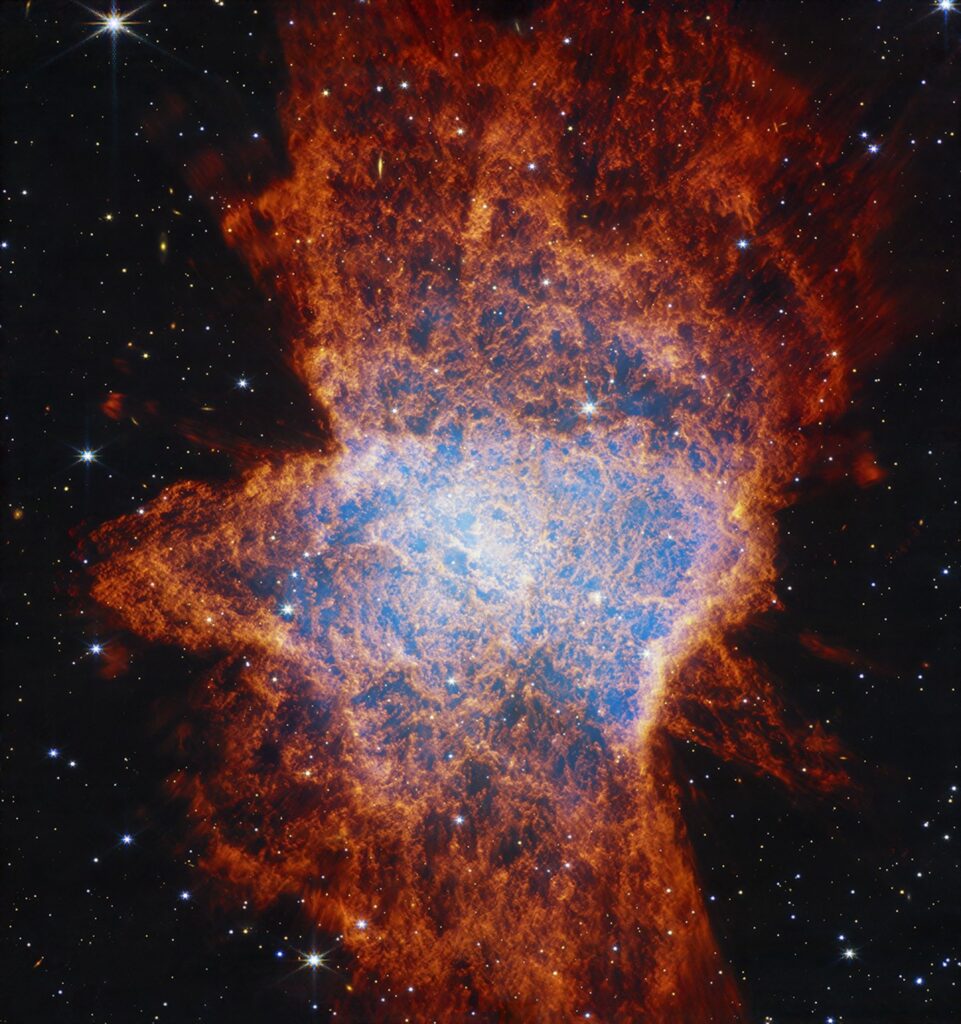
The Nebula NGC 6072 has recently come under the spotlight, thanks to the James Webb Space Telescope (JWST), which has captured a remarkably detailed image revealing its intricate structure. This planetary nebula, previously considered typical, is now known to be far more complex than astronomers had imagined. These new insights into Nebula NGC 6072 shed light on how stars end their lives and contribute to the creation of new ones.
In this blog, we’ll dive deep into how JWST’s near- and mid-infrared instruments have unraveled the unique structure and dynamics of Nebula NGC 6072, offering a powerful glimpse into stellar death and cosmic recycling.
What Is Nebula NGC 6072 and Why Does It Matter?
Nebula NGC 6072 is a planetary nebula, a glowing shell of gas and dust ejected by a dying low- to intermediate-mass star. While many planetary nebulae are known for their relatively symmetric shapes—circular, elliptical, or bipolar—the NGC 6072 breaks this trend with a chaotic, multi-lobed structure.
This makes it an important case study in understanding how different physical processes, such as stellar winds and binary interactions, contribute to the final appearance of planetary nebulae. The James Webb Space Telescope’s observations provide a rare opportunity to observe these mechanisms in action.
James Webb’s Unprecedented View of Nebula NGC 6072
The Nebula NGC 6072, as seen by JWST, resembles a cosmic paint splatter rather than a clean, symmetric structure. This unique appearance is due to multiple outflows of gas extending in different directions:
- One major outflow extends from the 11 o’clock to 5 o’clock position.
- Another runs from 1 o’clock to 7 o’clock.
- A possible third outflow spans from 12 o’clock to 6 o’clock.
These multi-polar features point to a much more complicated evolutionary history for NGC 6072 than previously believed.
Binary Stars at the Core of NGC 6072
At the heart of NGC 6072, astronomers now suspect the presence of a binary star system. One of the stars is in the late stages of its life, shedding mass in the form of gas and dust. The companion star’s gravitational pull disturbs the surrounding material, leading to the asymmetric structures and concentric rings now visible in the Webb images.
The JWST data supports the theory that binary star systems are crucial in shaping complex planetary nebulae like Nebula NGC 6072.
Nebula NGC 6072 in Near-Infrared: Clumps, Clouds, and Cores
JWST’s NIRCam (Near-Infrared Camera) has captured the core of NGC 6072 in exquisite detail. The central region glows in a light blue hue, representing the hot, ionized gases near the stellar core. Surrounding this region is dark orange material composed of gas and dust, appearing to flow through dark blue voids.
This patchy structure is believed to form when dense molecular clouds are shielded from the intense radiation of the central star. Such clumpiness is often missed in less detailed observations, making this a standout feature of the Nebula NGC 6072 images.
Mid-Infrared View: Rings and Hidden Stars in NGC 6072
The mid-infrared capabilities of JWST’s MIRI (Mid-Infrared Instrument) bring a new layer of depth to our understanding of Nebula NGC 6072. The images reveal several concentric rings that surround the central region, each one likely formed during different episodes of mass ejection.
There are two main theories explaining these rings:
- A binary companion carves out rings while orbiting the primary star, creating a bullseye-like pattern.
- The main star experienced pulsations, ejecting material in evenly spaced intervals.
Either way, these structures provide further evidence of the dynamic and ongoing interactions within NGC 6072.
Molecular Hydrogen and Dust Tracing in Nebula NGC 6072
Another fascinating feature of Nebula NGC 6072 is the presence of cool molecular hydrogen gas, detected in both the NIRCam and MIRI views. These gases trace the colder regions of the nebula—visible as red in NIRCam and blue in MIRI.
Meanwhile, hot ionized gas is found in the central area of NGC 6072, giving astronomers clues about the star’s current temperature and energy output. Together, these data help build a three-dimensional model of the nebula’s internal and external dynamics.
The Role of Time and Winds in Nebula NGC 6072’s Evolution
Over thousands of years, fast stellar winds emitted during later stages of the star’s life can plow through earlier, slower-moving materials. This interaction creates the intricate patterns now visible in Nebula NGC 6072.
Astronomers believe the clumpy material, rings, and lobes are the results of these wind interactions, shaped further by the gravitational tug of the companion star.
The Fate of Nebula NGC 6072
As the star at the center of Nebula NGC 6072 continues to cool and fade, the nebula itself will slowly dissipate into the interstellar medium. However, it won’t vanish in vain. The expelled material is rich in heavier elements—carbon, nitrogen, and oxygen—that enrich space and contribute to the formation of new stars and planets.
This cosmic recycling makes Nebula NGC 6072 an essential part of the galactic ecosystem, linking one generation of stars to the next.
Nebula NGC 6072 and the Bigger Picture
The Nebula NGC 6072 isn’t just visually striking; it’s scientifically crucial. By studying its unique structure, astronomers can learn:
- How binary systems influence nebula formation
- How mass loss occurs in dying stars
- How complex nebulae evolve over time
The Nebula NGC 6072 is now considered a key reference point for future studies of planetary nebulae with irregular or multi-polar structures.
Conclusion: Webb Opens a New Window into Nebula NGC 6072
The James Webb Space Telescope has opened a new chapter in our understanding of Nebula NGC 6072. With its dual-instrument capabilities, it has captured features previously unseen—rings, jets, molecular clouds, and even potential hidden stars—all pointing to a far more dynamic and intricate life cycle for planetary nebulae.
Nebula NGC 6072 is not just an object of beauty; it is a cosmic laboratory where the final moments of a star’s life are written in glowing gas and dust, sculpted by time, wind, and gravitational dance.